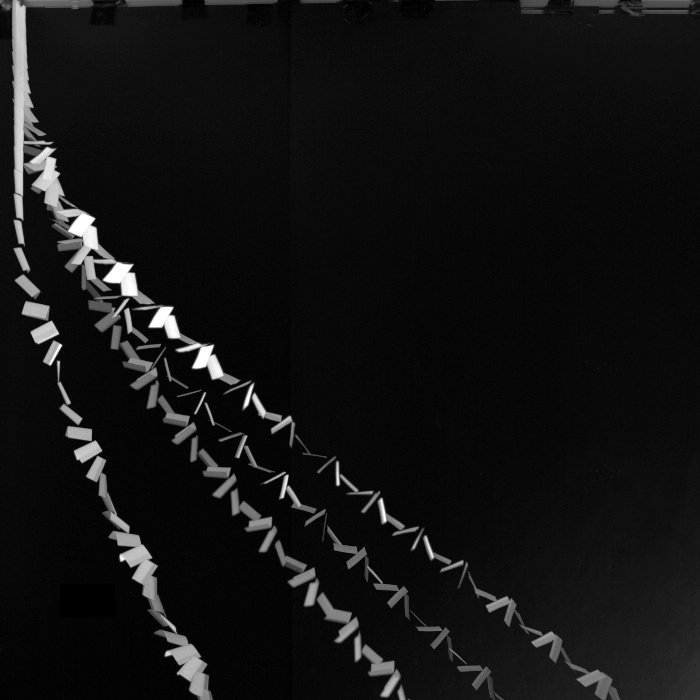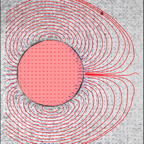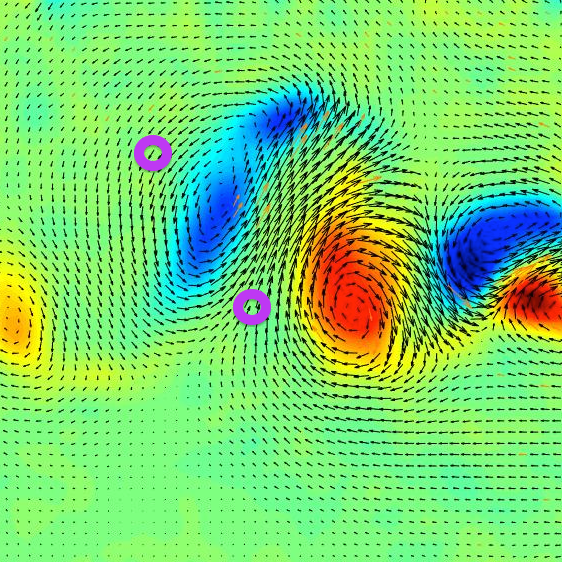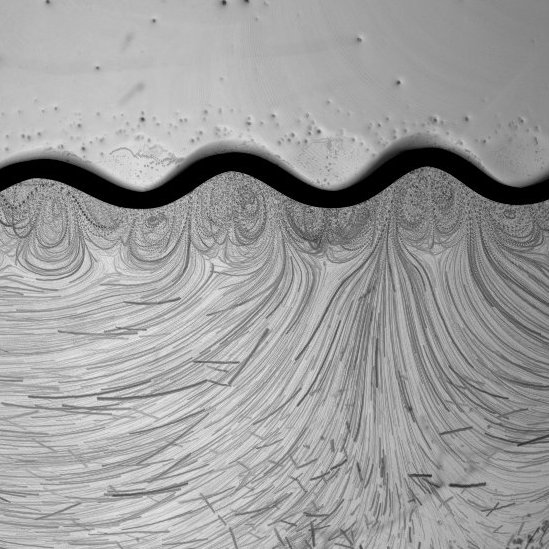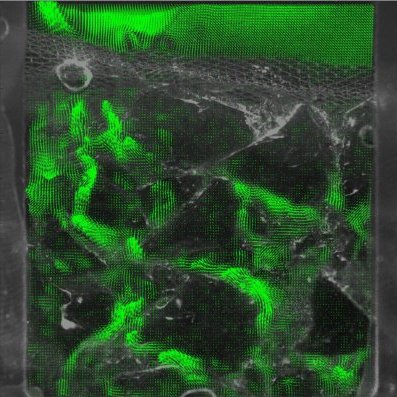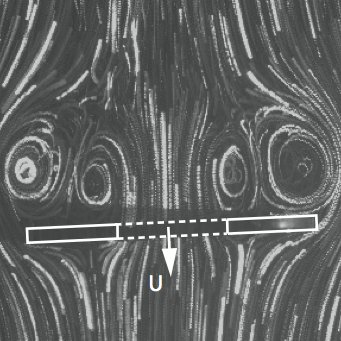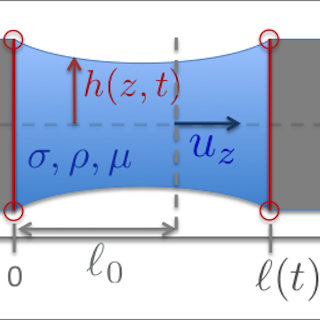
Lionel VINCENT
post-doctoral scholar - TIPs Lab

“An experiment is a question which we ask of Nature, who is always ready to give a correct answer, provided we ask properly, that is, provided we arrange a proper experiment."
Charles Vernon Boys, 1896
click on image for details about the project
Current Research
Water exit of cylinders and spheres
in collaboration with: Vincent Terrapon and Stéphane Dorbolo (U Liege)
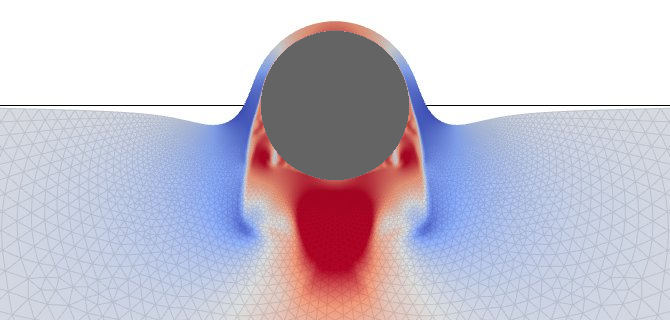 When an object is pulled out of a pool of fluid, it entrains a certain quantity of fluid that eventually drains down.
In this project, we aim to investigate the three steps of the water exit of an object, namely the crossing of the interface, the liquid entrainment, and the film drainage along the object,
The crossing of an object through a fluid interface is of particular importance for many applications that imply coating processes.
When an object is pulled out of a pool of fluid, it entrains a certain quantity of fluid that eventually drains down.
In this project, we aim to investigate the three steps of the water exit of an object, namely the crossing of the interface, the liquid entrainment, and the film drainage along the object,
The crossing of an object through a fluid interface is of particular importance for many applications that imply coating processes.
Past Research
Water entry of a wedge: Force and Splash
with students: Tingben Xiao and Daniel Yohann (USC), and Zeyad Sakr (Imperial College); in collaboration with Sunny Jung (Virginia Tech), Trung Le, Dennis Angelidis and Dean F. Sotiropoulos (Stony Brook University).
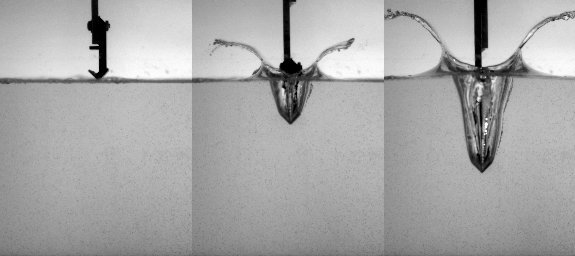 Birds such as cape gannets exhibit a remarkable fishing strategy: they dive head-first in the water. Before hitting the water, they streamline their body shape to minimize impact force.
To better understand the force generation during impact, we study the different aspects of the water entry of a two-dimensional wedge.
We focus specifically on the time-dependent impact force during entry (e.g., the existence of a maximum before total immersion of a wedge), but also on the the shape(s) of the splash, which proved to be strongly influenced by aerodynamics.
Birds such as cape gannets exhibit a remarkable fishing strategy: they dive head-first in the water. Before hitting the water, they streamline their body shape to minimize impact force.
To better understand the force generation during impact, we study the different aspects of the water entry of a two-dimensional wedge.
We focus specifically on the time-dependent impact force during entry (e.g., the existence of a maximum before total immersion of a wedge), but also on the the shape(s) of the splash, which proved to be strongly influenced by aerodynamics.
 Dynamics of Water Entry
Dynamics of Water Entry
L. Vincent, T. Xiao, D. Yohann, S. Jung, and E. Kanso
J. Fluid Mech. 846, pp. 508-535 (2018)
doi.org/10.1017/jfm.2018.273
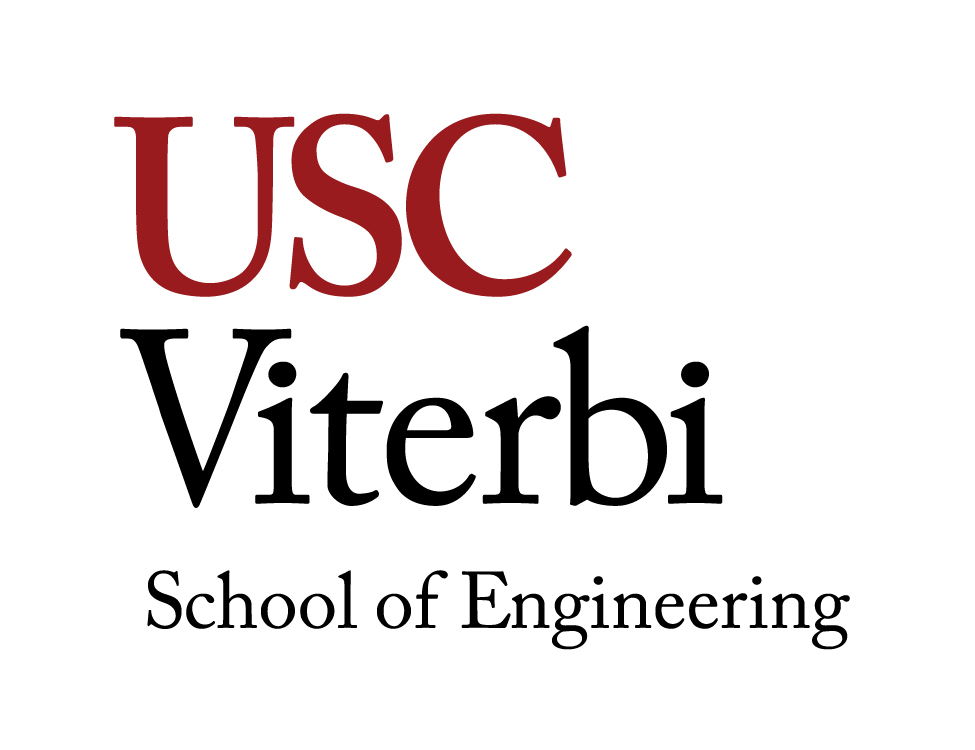 Check out the outreach article on Viterbi News (article by Ashleen Knutsen).
Check out the outreach article on Viterbi News (article by Ashleen Knutsen).
 Check out our 2016 APS Gallery of Fluid Motion Entry!
Check out our 2016 APS Gallery of Fluid Motion Entry!

 Check out the FYFD posts (#1 and #2) and D. Cowern (the Physics Girl)'s coverage!
Check out the FYFD posts (#1 and #2) and D. Cowern (the Physics Girl)'s coverage!
Falling coins: effects of geometry, flexibility, and medium stratification
with PhD student Try Lam, and undergrad students: Luke Heisinger, Scott Shambaugh and Lisa Maillard
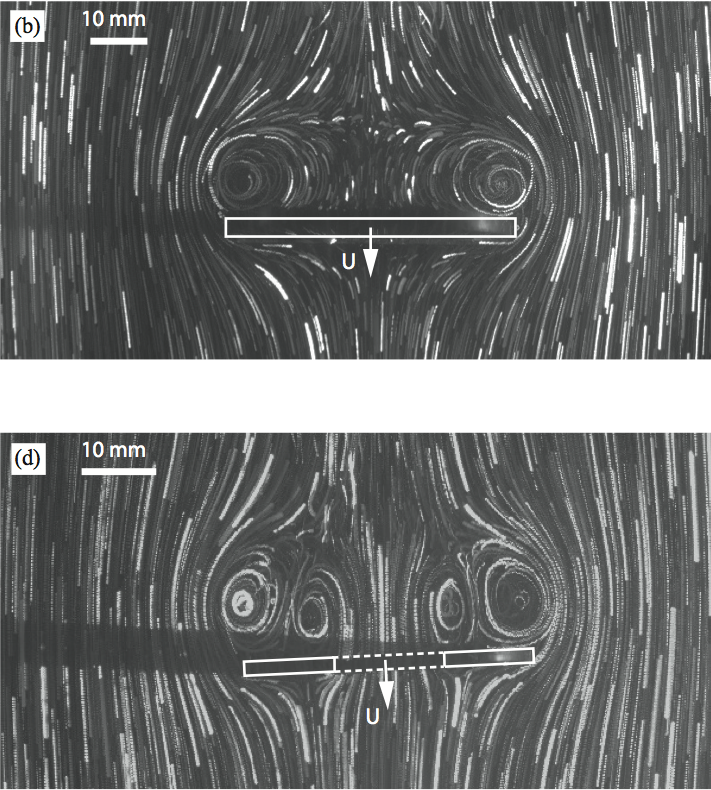 The free fall of heavy bodies in a viscous fluid medium is a problem of interest to many engineering and scientific disciplines, including unpowered flight, seed dispersal, and sedimentation.
Axisymmetric bodies such as coins may be one of the simplest body one can thinks of --yet they exhibit a large variety of behaviors: disks have previously been found to fall according to 4 different modes: straight, fluttering, tumbling, and chaotic (a combination of tumbling and chaotic).
In our lab, we investigate how simple geometric changes, such as a hole in the center, trigger transition from one descent mode to another.
We also investigate how the falling dynamics is affected by the medium stratification, thus extending the relevance of the results to naturally stratified environments such as the Earth atmosphere.
The free fall of heavy bodies in a viscous fluid medium is a problem of interest to many engineering and scientific disciplines, including unpowered flight, seed dispersal, and sedimentation.
Axisymmetric bodies such as coins may be one of the simplest body one can thinks of --yet they exhibit a large variety of behaviors: disks have previously been found to fall according to 4 different modes: straight, fluttering, tumbling, and chaotic (a combination of tumbling and chaotic).
In our lab, we investigate how simple geometric changes, such as a hole in the center, trigger transition from one descent mode to another.
We also investigate how the falling dynamics is affected by the medium stratification, thus extending the relevance of the results to naturally stratified environments such as the Earth atmosphere.
 Holes stabilize freely falling coins
Holes stabilize freely falling coins
L. Vincent, W. S. Shambaugh, and E. Kanso
J. Fluid Mech. 801, pp. 250-259 (2016)
doi.org/10.1017/jfm.2016.432
 Passive Flight in Density-Stratified Fluids
Passive Flight in Density-Stratified Fluids
T. Lam, L. Vincent, and E. Kanso
J. Fluid Mech., 860, pp. 200-223 (2019)
doi.org/10.1017/jfm.2018.862
 Check out Try's video on stratified flows!
Check out Try's video on stratified flows!
Auto-rotating wings : effect of flexibility, geometry and winglets
with John H. Costello, and students: Min Zheng, Yucen Liu and Mathieu Le Dizes
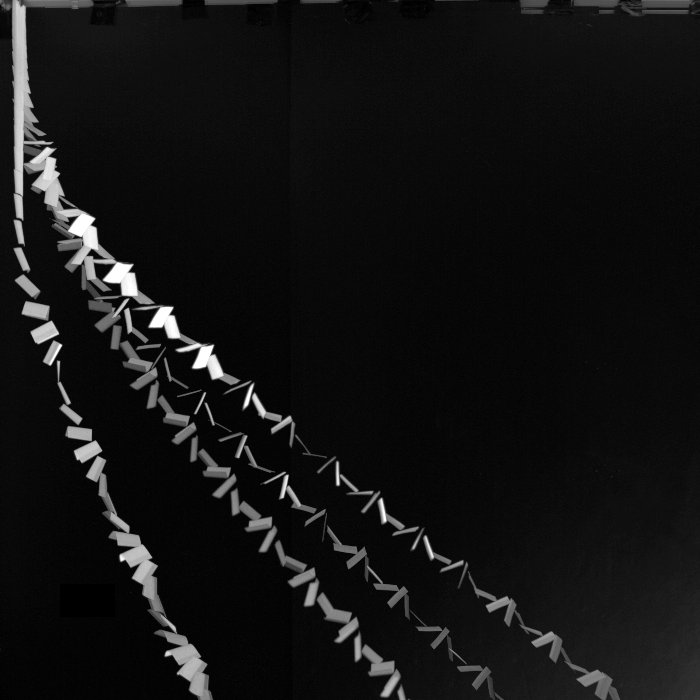 In the botanical world like in the animal world, survival depends on the ability to outperform competitors.
In particular, seed dispersal rely on the flight performance of seedpods, the shape of which have striking similarities despite the variety of size and flight modes.
We explore experimentally the fitness of auto-rotating flyers of various shapes, flexibility, and layout in a carefully controlled drop setup.
High-speed camera and in-house post-processing script are used to record all time-dependent parameters, such as velocity, and tumbling rate.
In parallel, we conduct wind tunnel experiments to quantify the aerodynamic differences. Ultimately, we seek to find design rules for optimal flight performance, that will likely reach beyond our initial scope.
In the botanical world like in the animal world, survival depends on the ability to outperform competitors.
In particular, seed dispersal rely on the flight performance of seedpods, the shape of which have striking similarities despite the variety of size and flight modes.
We explore experimentally the fitness of auto-rotating flyers of various shapes, flexibility, and layout in a carefully controlled drop setup.
High-speed camera and in-house post-processing script are used to record all time-dependent parameters, such as velocity, and tumbling rate.
In parallel, we conduct wind tunnel experiments to quantify the aerodynamic differences. Ultimately, we seek to find design rules for optimal flight performance, that will likely reach beyond our initial scope.
 Shape optimization of tumbling wings
Shape optimization of tumbling wings
L. Vincent, Y. Liu, and E. Kanso
J. Fluid Mech. 889, A9 (2020)
doi.org/10.1017/jfm.2020.88
 Enhanced flight performance in non-uniformly flexible wings
Enhanced flight performance in non-uniformly flexible wings
L. Vincent, M. Zheng, J. H. Costello, and E. Kanso
J. R. Soc. Interface 17: 20200352 (2020)
doi.org/10.1098/rsif.2020.0352
 Optimal winglet design of tumbling wings
Optimal winglet design of tumbling wings
L. Vincent, M. Le Dizès, and E. Kanso
in preparation
Biofilm in porous media
with Simonetta Rubol (USC / Stanford), Ken Nealson (USC) and Daniele Tonina (U Idaho)
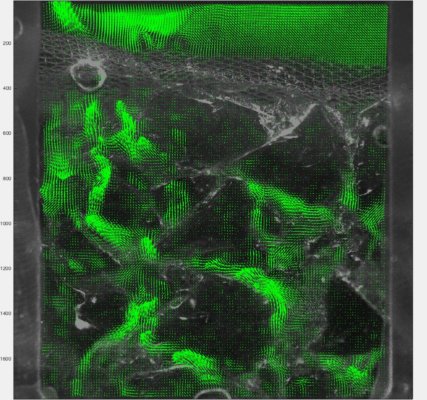 We developed a novel inexpensive method, utilizing particle image velocimetry (PIV) and refractive
index‐matching (RIM) for visualizing and quantifying the flow field within bio‐amended porous
media. The advantage of using water is that it provides, for the first time, the
opportunity to study both hydraulic and biological processes, which typically occur in soils
and streambeds. By using RIM coupled with PIV (RIM‐PIV), we measured the interstitial flow field
within a cell packed with granular material consisting of hydrogel grains in the presence and in the absence of Sinorhizobium meliloti bacteria. Results showed that the RIM‐PIV can measure the flow
field for both biofilm‐free and biofilm‐covered hydrogel grains. The fluorescent tracer
injection showed the ability to visualize both physical (concave surfaces and eddies) and
biological (biofilms) transient storage zones, whereas the fluorescent microbe treatment
showed the ability to track microbial movements within fluids. This methodology is a promising tool to visualize and quantify biofilm attachment, growth, and
detachment in a system closer to natural conditions than a 2D flow cell experiment.
We developed a novel inexpensive method, utilizing particle image velocimetry (PIV) and refractive
index‐matching (RIM) for visualizing and quantifying the flow field within bio‐amended porous
media. The advantage of using water is that it provides, for the first time, the
opportunity to study both hydraulic and biological processes, which typically occur in soils
and streambeds. By using RIM coupled with PIV (RIM‐PIV), we measured the interstitial flow field
within a cell packed with granular material consisting of hydrogel grains in the presence and in the absence of Sinorhizobium meliloti bacteria. Results showed that the RIM‐PIV can measure the flow
field for both biofilm‐free and biofilm‐covered hydrogel grains. The fluorescent tracer
injection showed the ability to visualize both physical (concave surfaces and eddies) and
biological (biofilms) transient storage zones, whereas the fluorescent microbe treatment
showed the ability to track microbial movements within fluids. This methodology is a promising tool to visualize and quantify biofilm attachment, growth, and
detachment in a system closer to natural conditions than a 2D flow cell experiment.
 Seeing through porous media: an experimental study for unveiling interstitial flows
Seeing through porous media: an experimental study for unveiling interstitial flows
S. Rubol, D. Tonina, L. Vincent, W. Basham, J. A. Sohm, W. Basham, R. Budwig, P. Savalia, E. Kanso, D. G. Capone, and K. H. Nealson
Hydrological Processes 32(3), pp. 402-407 (2018)
doi.org/10.1002/hyp.11425
Rheotaxis
with post-doctoral Arunima Bhattacharjee; in collaboration with Ned Ruby (University of Hawaii) and Janna Nawroth (Harvard University)
![]() Some organisms such as fish, seals and copepods are known to exhibit rheotaxis, that is a reaction to hydrodynamic changes in their environment.
Bacterial rheotaxis is on the other hand not well understood -yet it has the potential to shed light on many natural mechanisms.
V. fischeri is a bioluminscent marine bacteria recruited in a very selective process by the juvenie bobtail squid in order to help him hide on the seafloor.
To test wether rheotaxis is part of the process, we probe the reaction of V. fischeri to simple, controlled flows in a microfluidics setup.
Some organisms such as fish, seals and copepods are known to exhibit rheotaxis, that is a reaction to hydrodynamic changes in their environment.
Bacterial rheotaxis is on the other hand not well understood -yet it has the potential to shed light on many natural mechanisms.
V. fischeri is a bioluminscent marine bacteria recruited in a very selective process by the juvenie bobtail squid in order to help him hide on the seafloor.
To test wether rheotaxis is part of the process, we probe the reaction of V. fischeri to simple, controlled flows in a microfluidics setup.
 Under the microscope cover slip: spontaneous flows and bacterial behavior
Under the microscope cover slip: spontaneous flows and bacterial behavior
L. Vincent, and E. Kanso
Chaos, Complexity and Transport: Proceedings of the CCT’15 Conference on Chaos, Complexity and Transport, pp. 83-103 (2015)
doi.org/10.1142/9789813202740_0003
 Aggregation behavior of V. fischeri in vortices
Aggregation behavior of V. fischeri in vortices
L. Vincent, A. Battacharjee, J. Nawroth, and E. Kanso
in preparation
From local probing to global wake information
with students: Elaine Wu and Lorenzo Kustermann
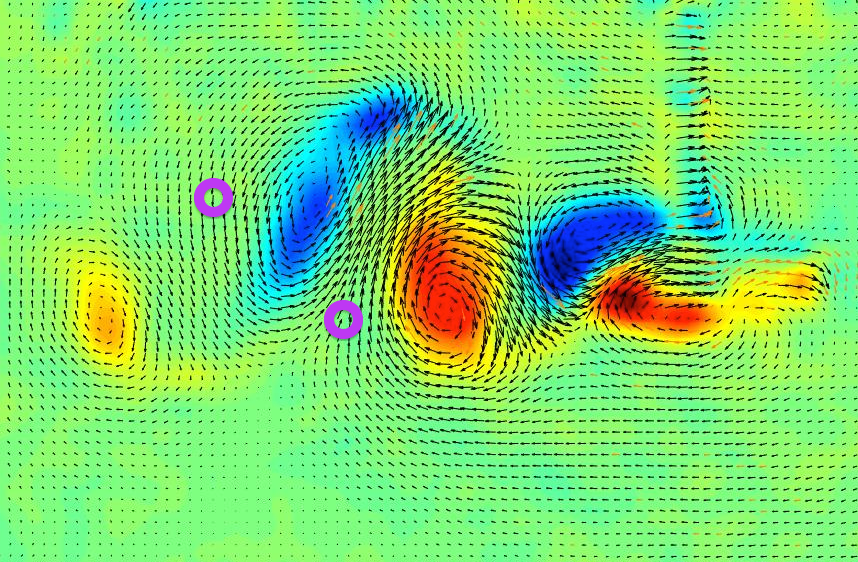
Fish exhibit remarkable abilities to respond to minute water motions. Among several sensory modalities, the fish lateral line sensory system is thought to play a major role in detecting hydrodynamic signals. Here, we propose an experimental model, consisting of two pressure sensors mounted in parallel or in tandem and placed in the wake of a cylinder towed at various speeds (i.e., Reynolds numbers) in an otherwise still fluid. Our goal is to reconstruct the salient flow features from local pressure measurements.
Faraday waves in Hele-Shaw cells
with students: Jesus H. C. Aguirre and Hilina Gudeta; in collaboration with Christel Hohenegger (U. Utah)
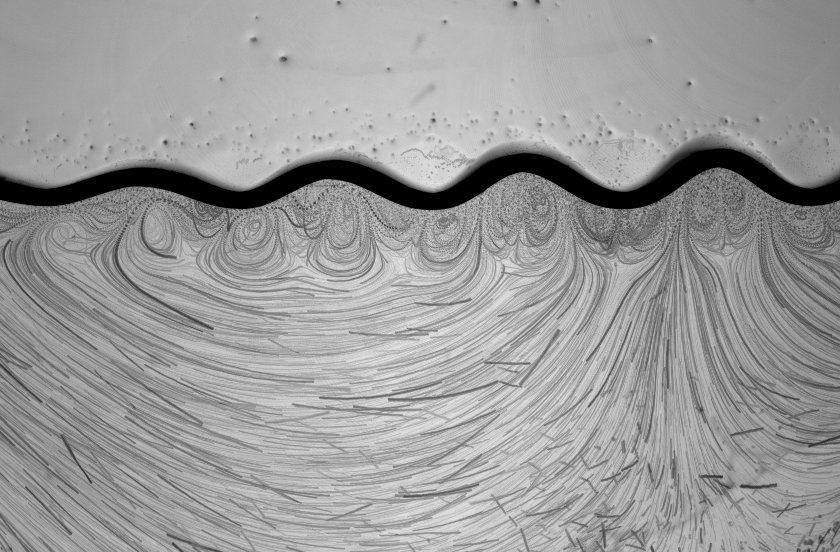 Faraday waves are parametrically-excited waves spontaneously occurring at the free-surface of a pool of liquid undergoing vertical vibrations.
Rather than using a large pool of liquid, we characterize the properties of these wave in a Hele-Shaw cell, where the cell thickness is smaller than any other dimension in the setup.
The waves' periodic motion excite a complex mixing flow both above and below the free-surface.
We investigate its dependance on the excitation parameters and explore the possibility to use these findings in engineering applications.
Faraday waves are parametrically-excited waves spontaneously occurring at the free-surface of a pool of liquid undergoing vertical vibrations.
Rather than using a large pool of liquid, we characterize the properties of these wave in a Hele-Shaw cell, where the cell thickness is smaller than any other dimension in the setup.
The waves' periodic motion excite a complex mixing flow both above and below the free-surface.
We investigate its dependance on the excitation parameters and explore the possibility to use these findings in engineering applications.
Breakup of ligaments subject to fast stretching (PhD work)
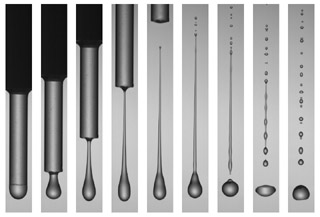 Pele's hair (see here), named after the Hawaiian goddess of volcanoes, are long solid filamentary structures found near volcanoes.
Their formation is believed to occur as followed : explosions into flowing lava generate locally high stretching rates that deform bridges of lava (between bigger blobs) into long and thin ligaments, able to solidify before breaking into droplets.
If we understand how Rayleigh-Plateau instability is affected by viscosity alone, the role of stretching (combined or not with viscosity) is, in contrast, poorly understood.
In our experiment, a liquid ligament is created by accelerating axially a solid millimetric cylinder (called rod) initially supporting a drop, or the top end of a liquid bridge.
The fluid volume deforms into a long needle-like ligament, that eventually disconnect from the top rod and atomize (shortly after).
We described the forces in play during stretching, and gave a prediction of the breakup time (which unexpectedly turned out to be independent of surface tension), as well as the breakup length.
Pele's hair (see here), named after the Hawaiian goddess of volcanoes, are long solid filamentary structures found near volcanoes.
Their formation is believed to occur as followed : explosions into flowing lava generate locally high stretching rates that deform bridges of lava (between bigger blobs) into long and thin ligaments, able to solidify before breaking into droplets.
If we understand how Rayleigh-Plateau instability is affected by viscosity alone, the role of stretching (combined or not with viscosity) is, in contrast, poorly understood.
In our experiment, a liquid ligament is created by accelerating axially a solid millimetric cylinder (called rod) initially supporting a drop, or the top end of a liquid bridge.
The fluid volume deforms into a long needle-like ligament, that eventually disconnect from the top rod and atomize (shortly after).
We described the forces in play during stretching, and gave a prediction of the breakup time (which unexpectedly turned out to be independent of surface tension), as well as the breakup length.
 Remnants from fast liquid withdrawal
Remnants from fast liquid withdrawal
L. Vincent, L. Duchemin and E. Villermaux
Phys. Fluids 26, 031701 (2014)
doi.org/10.1063/1.4921321
Forced dynamics of a stable short viscous liquid bridge (PhD work)
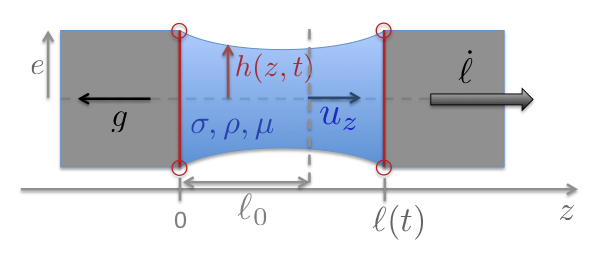 We investigated, numerically and theoretically, the dynamics of a liquid bridge held between two facing coaxial cylinders (rods), while moving one of the rod with various types of displacement.
The numerical part is based on a code making use of one-dimensionnal equations (known as "viscous slice model") that prove to be remarkably accurate for such free-surface problems.
The theoretical part relied on a weakly non-linear analysis of the same set of equations.
We explained how the static shapes of the bridge (Delaunay curves) are corrected by viscosity and the forcing of the right rod.
For large stretching or viscosity values, inducing large deformations of the bridge, one can expect the bridge to break while being stable according to the Rayleigh-Plateau criteria.
We investigated, numerically and theoretically, the dynamics of a liquid bridge held between two facing coaxial cylinders (rods), while moving one of the rod with various types of displacement.
The numerical part is based on a code making use of one-dimensionnal equations (known as "viscous slice model") that prove to be remarkably accurate for such free-surface problems.
The theoretical part relied on a weakly non-linear analysis of the same set of equations.
We explained how the static shapes of the bridge (Delaunay curves) are corrected by viscosity and the forcing of the right rod.
For large stretching or viscosity values, inducing large deformations of the bridge, one can expect the bridge to break while being stable according to the Rayleigh-Plateau criteria.
 Self-similar impulsive capillary waves on a ligament
Self-similar impulsive capillary waves on a ligament
L. Duchemin, S. Le Dizes, L. Vincent, and E. Villermaux
Phys. Fluids 27, 051704 (2015)
doi.org/10.1063/1.4921321
 Forced dynamics of a short viscous liquid bridge
Forced dynamics of a short viscous liquid bridge
L. Vincent, L. Duchemin, S. Le Dizès
J. Fluid Mech. 761 pp. 220-240 (2014)
doi.org/10.1017/jfm.2014.622
Highly-accelerated fluid layer around a cylinder (2010)
Industrial partnership with Saint-Gobain R&D
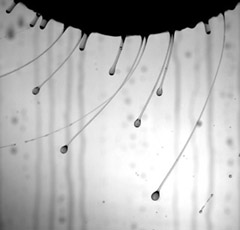 A viscous fluid layer is deposited upon a fast-rotating cylinder.
For it is subject to high radial acceleration, the fluid layer destabilize according to Rayleigh-Taylor instability,
giving birth, under a set of particular conditions, to nice elongated ligamentary structures ended by a head drop (coming from the capillary retraction of the tip of the filament).
The long lifetime of these unstable ligaments are favoured by both viscosity and elongation process that hinder the growth of perturbation by Rayleigh-Plateau mechanism.
While the head drop is close to ballistic motion, the body of the ligament is likely to be slowed down by the surrounding air, giving rise to this slight "S" shape.
The head drop eventually detaches from the ligament, leading, some moment later, to the atomization of the liquid filament.
A viscous fluid layer is deposited upon a fast-rotating cylinder.
For it is subject to high radial acceleration, the fluid layer destabilize according to Rayleigh-Taylor instability,
giving birth, under a set of particular conditions, to nice elongated ligamentary structures ended by a head drop (coming from the capillary retraction of the tip of the filament).
The long lifetime of these unstable ligaments are favoured by both viscosity and elongation process that hinder the growth of perturbation by Rayleigh-Plateau mechanism.
While the head drop is close to ballistic motion, the body of the ligament is likely to be slowed down by the surrounding air, giving rise to this slight "S" shape.
The head drop eventually detaches from the ligament, leading, some moment later, to the atomization of the liquid filament.


